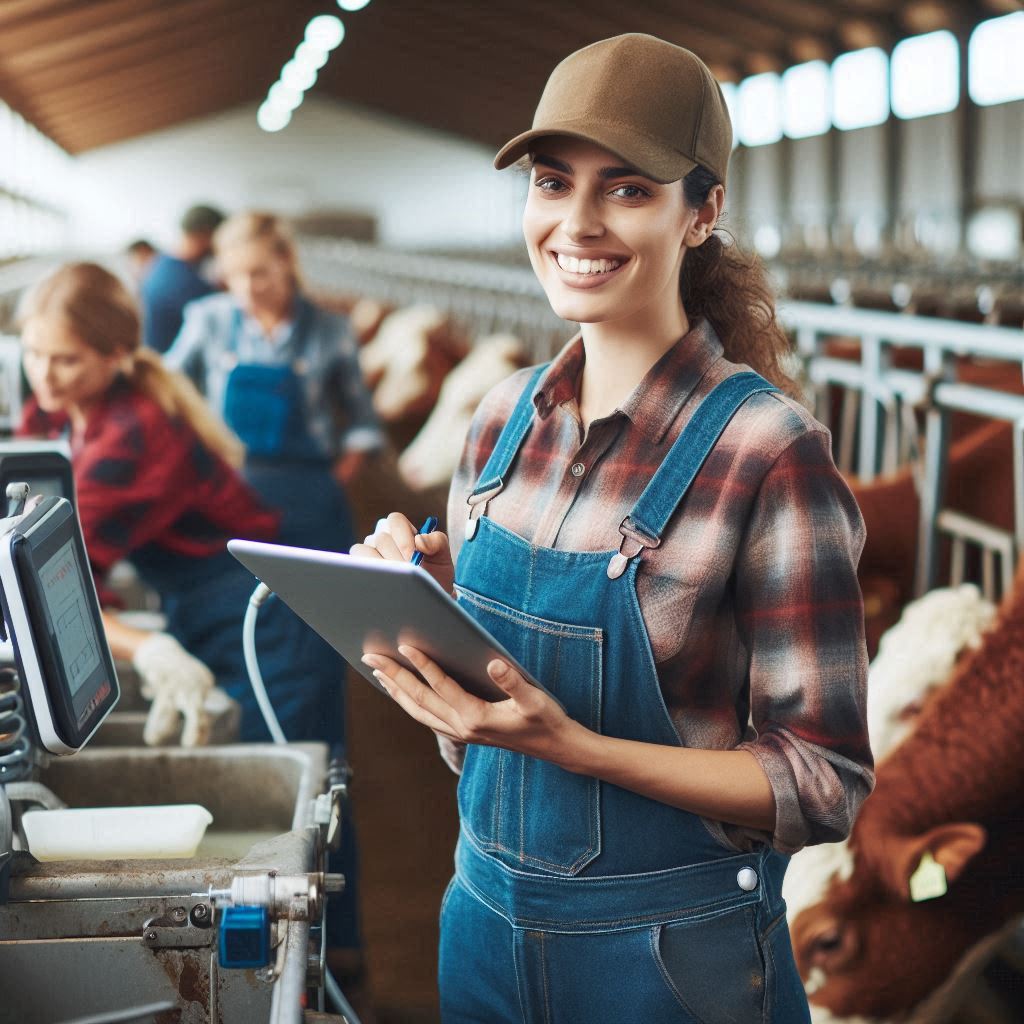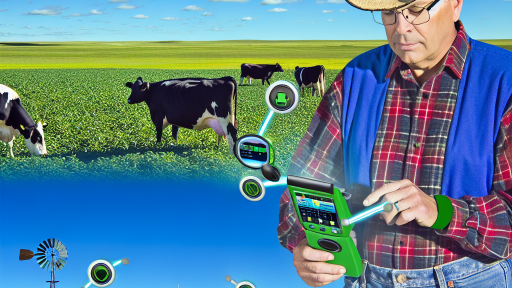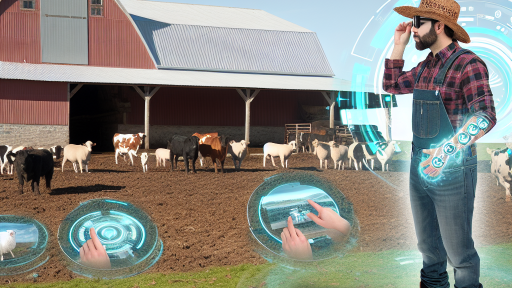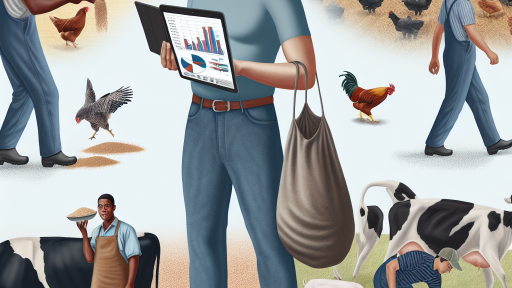Introduction
The livestock farming industry stands at a pivotal point today, shaping the future of livestock farming.
Farmers face numerous challenges, including climate change, rising feed costs, and labor shortages.
These factors compel farmers to seek innovative solutions that enhance productivity and sustainability.
Innovation plays a crucial role in addressing these challenges.
New technologies allow farmers to optimize resources, improve animal welfare, and enhance efficiency.
The adoption of automation and precision care is reshaping traditional farming practices.
Farmers now harness data-driven insights to make informed decisions about livestock management.
The purpose of this post is to explore how automation and precision care are transforming livestock farming.
We will examine the benefits of these innovations and their potential to create a sustainable future for the industry.
Current Challenges in Livestock Farming
Livestock farming faces numerous challenges that threaten its viability.
Traditional farming methods have served us for generations.
However, these methods are becoming less effective in today’s world.
As demands on food production increase, farmers must adapt or risk falling behind.
Limitations of Traditional Farming Methods
Traditional farming methods involve manual labor and basic equipment.
While they may have worked in the past, they present significant limitations today.
- Labor-Intensive: Traditional farming requires substantial human labor for feeding, monitoring, and maintaining livestock.
- Inconsistent Practices: Farmers often rely on their experience, leading to variations in care and management.
- Resource Inefficiency: Manual processes can lead to waste of resources such as feed and water.
- Time-Consuming: Routine tasks take time and delay farmers’ ability to respond to urgent issues.
Key Issues Impacting the Industry
The livestock farming industry faces multiple challenges that hinder productivity and sustainability.
- Labor Shortages: There is a growing shortage of workers willing to engage in agricultural jobs.
Many rural areas struggle to fill these positions. - Climate Change: Changing weather patterns affect feed production and animal health.
Extreme weather can devastate farms, leading to significant losses. - Animal Health Concerns: Disease outbreaks pose a serious threat.
Farmers must remain vigilant and responsive to health threats among their livestock. - Sustainability Challenges: Consumers increasingly demand sustainable farming practices.
Farmers must adopt methods that reduce environmental impact.
The Economic Impacts of Inefficiency
The inefficiencies in traditional livestock farming lead to significant economic consequences.
Farmers face tight profit margins and rising costs, making sustainability vital.
- Increased Production Costs: Ineffective resource usage results in higher operational expenses.
This affects the entire supply chain. - Market Competitiveness: Inefficient farms struggle to compete with more technologically advanced operations.
This can lead to market share loss. - Food Safety Risks: Poor practices can result in food safety issues.
This may lead to recalls and loss of consumer trust. - Long-term Viability: Without adopting new practices, many farms risk becoming obsolete.
Economic pressures mount, threatening their sustainability.
As these challenges mount, the need for modern solutions grows more urgent.
Enter automation and precision care technology.
These innovations promise to revolutionize livestock farming.
They address traditional challenges while ensuring profitability, efficiency, and sustainability.
By embracing these tools, farmers can enhance their operations significantly.
Automation can streamline processes while precision care can improve animal health and productivity.
As we navigate the complex future of livestock farming, these advancements will play a crucial role.
Overview of Automation in Livestock Farming
Automation in livestock farming refers to the use of technology to streamline various farming operations.
This technology encompasses a range of tools, equipment, and software.
Automation enhances efficiency and productivity in livestock management.
It also reduces labor costs and improves the quality of life for farmers.
The adoption of automation leads to more sustainable farming practices.
Definition and Explanation of Automation Technologies Relevant to Livestock Farming
Automation technologies come in various forms and serve different purposes.
These technologies aim to minimize human intervention while maximizing operational efficiency.
Below are key technologies relevant to livestock farming:
- Robotics: Robots perform tasks such as feeding animals, cleaning barns, and even milking cows.
- Drones: Drones help with surveillance, monitoring crop health, and evaluating livestock locations.
- Internet of Things (IoT) Devices: IoT devices collect real-time data on livestock health and environment.
- Automated Feed Systems: These systems dispense the right amounts of feed to different livestock categories.
- Precision Livestock Farming (PLF): PLF uses technology to monitor animals closely, ensuring their optimal health and productivity.
Examples of Technologies in Action
Automation technologies are transforming livestock farming with real-world applications.
Here are some examples illustrating their effectiveness:
- Robotic Milking Systems: These systems allow cows to be milked automatically.
Farmers can monitor milk production remotely, leading to better management. - Drones for Herd Monitoring: Farmers deploy drones to track herds across large pastures.
Drones provide real-time imagery that aids in health assessments. - Wearable Devices for Livestock: Just like humans, animals wear collars that monitor vital signs.
This data helps farmers take preventive action against diseases. - Automated Fencing Systems: These systems control livestock movement.
Farmers can manage grazing patterns without manual labor. - Smart Barns: Technology-enabled barns can regulate temperature, humidity, and air quality.
This creates a healthier environment for livestock.
Benefits of Automation in Enhancing Operational Efficiency and Productivity
Automation brings several significant benefits to livestock farming.
Farmers experience profound changes in their operations, leading to better outcomes.
Some of these benefits include:
- Increased Productivity: Automation enables farmers to manage larger operations efficiently.
Robots and automated systems complete tasks faster than human workers. - Labor Cost Reduction: Automation reduces the need for manual labor, lowering overall operational costs.
- Improved Animal Welfare: With precise monitoring, farmers can address health issues promptly, ensuring better care for livestock.
- Enhanced Data Collection: Automation facilitates data collection, allowing farmers to make informed decisions.
- Time Savings: Farmers can focus on strategic decisions rather than daily repetitive tasks. This shift enhances overall farm management.
- Better Resource Management: Automated systems help optimize feed and water use, minimizing waste.
- Consistent Quality: Automation ensures that livestock receive consistent care, leading to uniform quality products.
- Environmental Sustainability: Smart farming practices reduce overuse of resources, contributing to better environmental stewardship.
The Road Ahead for Automation in Livestock Farming
The future of livestock farming lies in continued advancements in automation.
Innovations in technology will drive this evolution.
Here are key trends to watch:
- Advanced Robotics: Future robotic systems will perform more complex tasks.
They will integrate artificial intelligence capabilities for better decision-making. - IoT Integration: Expect more IoT devices to connect in a smarter farming ecosystem.
This integration will enhance real-time data analysis. - Data Analytics: Data-driven insights will play a critical role in farm management.
Farmers will leverage analytics for improved livestock health. - Collaboration Between Tech Companies and Farmers: Partnerships will spur innovation.
Collaborative efforts will focus on creating tailored solutions for specific farming needs. - Increased Sustainability Efforts: Automation will aid in achieving sustainability goals.
More farmers will adopt eco-friendly practices through technology.
Automation in livestock farming promises a significant transformation.
Farmers who embrace these technologies will likely experience vast improvements.
Enhanced operational efficiency and productivity will mark the future of the industry.
Innovation will pave the way for better farming practices, ensuring a sustainable approach to livestock management.
Transform Your Agribusiness
Unlock your farm's potential with expert advice tailored to your needs. Get actionable steps that drive real results.
Get StartedRead: What Every Cattle Farmer Should Know About Disease Prevention
Precision Care: The New Approach
Precision care in livestock farming revolutionizes traditional methods.
This approach emphasizes data-driven decisions to enhance animal welfare and farm productivity.
By implementing precision care techniques, farmers can closely monitor their livestock’s health and manage resources effectively.
This method aligns well with modern technological advancements, leading to significant improvements in the livestock industry.
Understanding Precision Farming Concepts
Precision farming involves integrating technology into farming practices.
It takes into account the various factors affecting livestock and their environment.
Key components of precision farming include:
- Data Collection: Gathering data on animal health, nutrition, and environmental conditions.
- Real-time Monitoring: Utilizing tools that provide immediate insights into animals’ well-being.
- Customized Care: Tailoring nutrition and healthcare plans based on individual animal needs.
- Resource Optimization: Enhancing feed efficiency and minimizing waste.
These factors help farmers achieve better output while ensuring ethical treatment of livestock.
The Relevance of Precision Care to Livestock
Precision care directly impacts the way farmers manage their herds.
It optimizes animal health, improves production rates, and minimizes the environmental impact.
Some key advantages include:
- Increased Productivity: By monitoring health and behavior, farmers can enhance growth and production.
- Improved Animal Welfare: Timely interventions lead to better health outcomes and reduced stress.
- Cost Efficiency: Reducing feed waste and medical expenses through tailored care practices.
- Sustainability: Less environmental footprint by using resources more wisely.
Understanding these benefits encourages farmers to adopt precision care methods.
Tools and Techniques for Precision Care
Implementing precision care requires cutting-edge tools and techniques.
Various technologies facilitate the monitoring and management of livestock effectively.
Important tools include:
- Sensors: Devices that track vital signs, movements, and behaviors in real-time.
- Data Analytics: Software that processes collected data to produce actionable insights.
- Devices worn by animals that collect health metrics and behavioral data.
- Smart Feeding Systems: Automate the distribution of feed based on individual animal requirements.
These tools provide farmers with a holistic view of their livestock’s health and well-being.
The integration of technology helps in making informed decisions that promote better care.
Case Studies Showcasing Successful Implementation
Numerous farms have adopted precision care, achieving remarkable results.
These case studies highlight the effectiveness of this approach:
- Farm A (Cattle Ranch): This farm utilizes wearable sensors to monitor the health of its cattle.
This data enables farmers to detect health issues early.
As a result, they saw a 20% increase in overall herd health within a year. - Farm B (Dairy Operation): A dairy farm implemented data analytics to optimize feeding techniques.
By personalizing the diet based on each cow’s nutritional requirements, they reduced feed costs by 15% while increasing milk yield. - Farm C (Pig Farming): This farm adopted air quality sensors to monitor pig housing.
Improved air quality led to a remarkable decrease in respiratory diseases, enhancing animal welfare and productivity. - Farm D (Poultry Farm): Implementing smart feeding systems allowed this farm to provide targeted nutrition to each bird.
The farm reported a 10% reduction in feed wastage and improved growth rates.
These examples underscore how precision care transforms livestock farming.
The successful application of technology leads to better outcomes for farmers and animals alike.
The Future of Precision Care in Livestock Farming
The future of livestock farming lies in the continued evolution of precision care practices.
As technologies develop, farmers will benefit even more.
Some potential trends include:
- Integration of AI: Incorporating artificial intelligence to further enhance decision-making processes.
- Blockchain for Traceability: Using blockchain technology to ensure the transparency of livestock products.
- Multi-species Monitoring: Expanding precision care approaches to include various livestock species.
- Collaborative Farming: Enhanced communication between farmers for sharing data and best practices.
These advancements will shape the farming landscape in the coming years.
By embracing precision care, the livestock industry can meet increasing global demands sustainably.
In fact, precision care represents a promising approach to modern livestock farming.
It not only enhances animal welfare but also increases productivity and protects the environment.
Farmers investing in precision farming technologies position themselves at the forefront of an evolving industry.
The integration of data-driven practices ultimately ensures a healthier future for livestock farming.
Read: Top Livestock Management Tips from Expert Farmers

Integration of Artificial Intelligence (AI) and Machine Learning
Artificial Intelligence (AI) and machine learning revolutionize livestock farming.
These technologies optimize operations, enhance productivity, and improve animal welfare.
Farmers can monitor and manage livestock health with unprecedented precision.
Utilizing data analytics, they can identify trends and make informed decisions.
AI applications in livestock farming show promising advancements.
Overview of AI Applications in Monitoring and Managing Livestock Health
AI offers innovative solutions for monitoring livestock health.
Sensors and wearable technology gather real-time data.
Keep track of vital signs, activity levels, and feeding behaviors all through these devices.
Such AI-driven monitoring systems provide early warnings for potential health issues.
- Wearable devices track individual animal activity.
- Smart cameras utilize image recognition for monitoring health conditions.
- Automated feeding systems ensure optimal nutrition based on real-time data.
- AI algorithms analyze historical data to predict health outcomes.
Farmers utilize these technologies to respond quickly to health concerns.
Rapid response minimizes the risk of disease spread.
Smart barns equipped with AI ensure a conducive environment for animals.
These barns adjust temperature, humidity, and ventilation automatically.
Predictive Analytics for Disease Prevention and Management
Predictive analytics harnesses large datasets for informed decision-making.
It allows farmers to anticipate health crises before they occur.
By analyzing data from various sources, predictive models identify potential issues early.
- Historical health records provide insights into disease patterns.
- Environmental data identifies stress factors affecting livestock health.
- Genetic information helps tailor prevention strategies.
- Feed composition influences livestock’s immunity and overall health.
Farmers can utilize predictive analytics to administer vaccinations timely.
This proactive approach mitigates severe outbreaks.
It leads to a healthier livestock population and reduces economic losses.
Furthermore, data-driven insights foster transparency in livestock management.
Enhancing Breeding Programs Through Data-Driven Insights
Data-driven insights significantly enhance breeding programs.
Farmers can utilize genetic data to inform selection choices.
AI technologies analyze genetics, health, and productivity traits efficiently.
- Genotype data helps identify optimal breeding pairs.
- Health and production data support breeding for disease resistance.
- Performance records lead to continuous improvement in livestock traits.
- AI-assisted breeding ensures higher yield and quality of produce.
By leveraging these insights, farmers can optimize their genetic stock.
Improved traits lead to better growth rates and reproductive performance.
This enhances the overall productivity of livestock farming.
Implementing AI Solutions on the Farm
Integrating AI solutions requires careful planning and execution.
Farmers should consider several factors before implementation.
Investment in technology, training, and infrastructure is crucial for success.
- Assess the specific operational needs of the farm.
- Choose appropriate AI tools and technologies based on those needs.
- Provide training for staff to ensure effective use of technologies.
- Monitor the performance of AI solutions regularly.
Engaging with technology partners can ease the transition.
These partners often provide valuable insights and support during the implementation phase.
Proper integration of these solutions not only boosts productivity but also improves sustainability in livestock farming.
The Future Impact of AI and Machine Learning
The ongoing integration of AI and machine learning will reshape livestock farming.
Greater efficiencies and reduced workloads will become prevalent.
Moreover, enhanced animal welfare through real-time monitoring will gain further emphasis.
Showcase Your Farming Business
Publish your professional farming services profile on our blog for a one-time fee of $200 and reach a dedicated audience of farmers and agribusiness owners.
Publish Your Profile- Predictive analytics will lead to smarter health management.
- Data-driven breeding programs will yield stronger, healthier livestock.
- AI innovations will streamline operations and reduce manual labor.
- Farmers will have the insights needed to make informed decisions quickly.
As technology evolves, farmers will find new opportunities to improve their practices.
The combination of AI and machine learning will allow for environmental sustainability.
This can set a new precedent for the future of livestock farming.
The integration of AI and machine learning into livestock farming holds tremendous potential.
Enhanced monitoring and management applications lead to healthier livestock.
Predictive analytics enables proactive health measures, reducing risks.
Furthermore, data-driven breeding contributes to productivity and sustainability.
As the industry embraces these innovations, the future of livestock farming appears brighter than ever.
Read: Latest Milking Tech: Revolutionizing Dairy Farms
Sustainability and Environmental Impact
As the global population grows, livestock farming faces increased scrutiny regarding its environmental impact.
Fortunately, automation and precision care can lead the way toward sustainable farming practices.
By leveraging technology, farmers can reduce resource waste and environmental damage.
These innovative practices ensure a healthier planet for future generations.
How Automation and Precision Care Contribute to Sustainable Practices
- Automation facilitates a higher degree of efficiency on farms.
This efficiency leads to better use of resources. - Precision care utilizes data analytics to optimize livestock management.
This results in improved feed conversion ratios. - Automated systems monitor animal health in real-time.
Early detection of health issues reduces the need for extensive treatments. - Technology-driven farms can track and manage greenhouse gas emissions.
This information helps farmers implement strategies to lower their carbon footprints.
These transformative technologies support sustainable practices in a variety of ways.
Automation helps farmers maximize productivity without expanding land use.
onsequently, farms can produce more food while minimizing environmental degradation.
Strategies for Reducing Carbon Footprints and Waste Management
Farmers can adopt several strategies to reduce their carbon footprints effectively.
Many of these strategies depend on integrating technology into everyday operations:
- Implementing precision livestock farming technologies allows farmers to manage feeding more effectively.
This minimizes overfeeding and reduces methane emissions. - Using automated manure management systems can improve waste handling.
These systems reduce nutrient runoff and the pollutant load on nearby water bodies. - Investing in renewable energy sources, such as solar panels, can reduce reliance on fossil fuels.
This transition lowers the overall carbon footprint of operations. - Incorporating cover crops in grazing areas boosts soil health.
Healthy soils store more carbon, ultimately sequestering greenhouse gases. - Utilizing data analytics helps farmers gauge their energy consumption.
This information allows for targeted strategies to lower energy use.
These waste management techniques ensure that livestock farming becomes a more sustainable practice.
Farmers who employ these strategies not only contribute to environmental protection but also improve farm profitability over time.
The Role of Technology in Improving Resource Efficiency
Technology plays a critical role in enhancing resource efficiency in livestock farming.
Efficient use of resources such as water, feed, and land is essential for sustainable farming:
- Smart irrigation systems can reduce water usage significantly.
These systems optimize water delivery based on real-time weather data and soil conditions. - Feed efficiency can be greatly improved through feed formulation technologies.
Nutritional analytics allow farmers to match diets specifically to animal needs. - Land use planning software assists in maximizing land potential.
This allows farmers to produce higher yields on existing farmland. - Implementing advanced breeding programs can create healthier livestock.
Healthier animals require fewer resources and produce less waste. - Utilizing IoT devices aids in monitoring resource consumption.
This constant tracking allows farmers to adjust inputs proactively.
These advancements showcase how technology can lead to improved resource efficiency.
Farmers who adopt these tools not only enhance productivity but also contribute positively to the environment.
The future of livestock farming hinges on sustainability and environmental responsibility.
Automation and precision care offer innovative solutions to traditional farming problems.
By harnessing these technologies, farmers can significantly reduce their carbon footprints.
Moreover, enhanced resource efficiency supports both economic and environmental health.
Moving forward, it is essential for farmers to embrace these changes.
Sustainability will become a central theme in agriculture.
The proactive adoption of technology ensures that livestock farming can thrive in harmony with the environment.
In turn, this commitment will safeguard food security for generations to come.
Read: Solar Power in Livestock Farming: A Guide
Challenges and Considerations in Adopting New Technologies
As agriculture evolves, livestock farming faces unique challenges when adopting new technologies.
Understanding these challenges is crucial for farmers considering automation and precision care.
In this section, we will explore barriers to adoption, ethical considerations regarding animal welfare, and future regulatory frameworks.
Barriers to Adoption
The journey towards embracing automation and precision care in livestock farming presents several barriers.
Farmers often confront the following challenges:
- Cost: Implementing new technologies can be expensive.
Initial investments in robotics, sensors, and software can strain budgets, especially for small-scale farmers. - Training: Farmers and workers need proper training to operate advanced systems.
The learning curve can deter adoption, especially for older generations. - Resistance to Change: Farmers often feel comfortable with traditional methods.
This comfort can create hesitance to invest in unfamiliar technology. - Infrastructure Limitations: Existing facilities may not support new technologies.
Upgrading infrastructure can lead to higher costs and logistical challenges. - Insecurity about ROI: Many farmers question the return on investment for automated systems.
Uncertainty may lead to hesitance in adopting new technologies.
Cost Implications
The financial aspect of adopting technology in livestock farming cannot be ignored.
Here are some cost-related factors to consider:
- Initial Investment: Automated systems, such as feeding robots or health monitoring devices, often require substantial upfront costs.
- Maintenance Costs: Automation technologies may incur ongoing maintenance expenses.
These can add to the overall investment burden. - Data Management: Investing in data analytics tools is often necessary.
Farmers may need to hire specialists for effective data management.
Training Needs
Adopting new technologies necessitates a shift in how farmers think and operate.
Training plays a vital role in this transition:
- Skill Development: Farmers must enhance their technical skills to navigate software and machinery.
- Workshops and Seminars: Participating in education programs can help ease the transition to automation.
- Support Networks: Building relationships with tech providers fosters knowledge sharing and encourages adaptation.
Resistance to Change
Change is often met with skepticism in established industries.
Resistance can stem from several factors:
- Cultural Norms: Traditional practices create strong cultural ties.
Moving away from familiar methods can be daunting. - Fear of Job Loss: Workers may fear new technologies will render their jobs redundant.
This fear can create resistance among employees. - Perceived Complexity: Farmers may believe automation is too complex and not worth the effort to learn.
Ethical Considerations
As livestock farming shifts towards automation and precision care, ethical considerations regarding animal welfare emerge.
Key ethical discussions include:
- Animal Welfare: Automated systems must prioritize the health and comfort of livestock.
Farmers need to ensure these technologies do not compromise welfare standards. - Natural Behaviors: Technologies should allow animals to express their natural behaviors.
Restrictive systems can lead to stress and harm. - Monitoring and Data Use: Continuous health monitoring raises ethical questions regarding data collection and usage.
Farmers must use data responsibly.
Impact on Animal Welfare
While automation can enhance efficiency, it poses risks to animal welfare.
Consider the implications:
- Isolation: Automated systems may lead to reduced human-animal interaction.
Animals thrive with social contact. - Inflexibility: Rigid systems might not accommodate individual needs of livestock.
A one-size-fits-all approach is often unsuitable. - Stress Indicators: Continuous monitoring must accurately interpret signs of stress or discomfort in animals.
Future Regulatory Frameworks
The trajectory of livestock farming will also be shaped by future regulatory frameworks.
These frameworks will influence the adoption of automation technologies:
- Standards for Automation: Regulatory bodies may establish standards governing automated systems to ensure they meet animal welfare requirements.
- Data Use Regulations: Rules regarding data privacy and usage will become increasingly important.
Farmers must navigate these legal landscapes responsibly. - Training and Certification: Regulatory measures may mandate specific training and certification programs for farmers and their workers.
Potential Impact of Regulation
The implications of new regulations can significantly impact livestock farming:
- Compliance Costs: Adhering to new regulations may increase operational costs.
Farmers will need to budget for compliance efforts. - Market Access: Regulations can determine access to broader markets.
Compliance might be necessary to meet consumer expectations. - Innovation Encouragement: Regulations can stimulate innovation by establishing requirements that drive technology development.
In general, while the adoption of automation and precision care in livestock farming offers numerous benefits, challenges remain.
Barriers such as cost, training, and resistance to change demand attention.
Ethical considerations regarding animal welfare must guide decisions.
Furthermore, future regulatory frameworks hold the power to shape both technologies and practices in livestock farming.
By addressing these challenges, the industry can embrace a future that balances efficiency with ethical responsibility.
The Role of Education and Training for Farmers
The future of livestock farming looks bright, but it requires farmers to adapt.
As automation and precision care technologies advance, these changes demand a new set of skills.
Upskilling is crucial for farmers to successfully integrate these emerging practices into their operations.
Importance of Upskilling in the Context of Advancing Technology
Farmers can no longer rely solely on traditional farming methods.
They must embrace modern technologies to remain competitive.
Here are several reasons why upskilling is essential:
- Enhances Productivity: Upskilling allows farmers to use technology effectively.
This leads to increased productivity and efficiency on farms. - Improves Animal Welfare: Knowledge of precision care enables farmers to monitor animal health accurately.
This improved oversight promotes better animal welfare. - Increases Profitability: Leveraging technology can help farmers reduce costs.
They can save on labor and operational expenses, boosting their profits. - Addresses Labor Shortages: Many agricultural regions face labor shortages.
Automation can help fill these gaps, but farmers need training to use these tools. - Stays Competitive: The livestock industry evolves rapidly.
Farmers must stay updated on new technologies to compete effectively in the market.
Resources Available for Farmers to Learn About Automation and Precision Care
Many resources exist to help farmers expand their knowledge of automation and precision care.
Here are a few notable options:
- Online Courses: Universities and agricultural associations offer online courses.
These courses cover various topics related to livestock farming and technology. - Workshops: Local agricultural extension offices often hold workshops.
These sessions provide hands-on experience with new tools and techniques. - Webinars: Many organizations host webinars featuring industry experts.
These webinars discuss the latest trends in precision care and automation technologies. - Publications: Trade journals and magazines focus on livestock farming innovations.
Reading these publications helps farmers stay informed about new developments. - Social Media: Farmers can connect with peers and experts through social media platforms.
Online communities provide an avenue for sharing experiences and advice.
Collaborations Between Technology Providers, Educational Institutions, and Farmers
Effective learning often involves collaboration.
Partnerships can amplify the benefits of resources for farmers.
Here are ways these collaborations manifest:
- Joint Research Initiatives: Technology providers and educational institutions often collaborate on research.
This research advances agricultural science and helps develop new technologies. - Training Programs: Many technology companies partner with universities to create training programs.
These programs help farmers understand how to use new technologies. - Community Engagement: Companies can engage with local farming communities.
These engagements foster learning and encourage farmers to adopt new practices. - Mentorship Opportunities: Experienced farmers can mentor those new to technology.
Mentorship fosters knowledge transfer and practical skill development. - Demo Days: Technology providers often organize demo days to showcase their products.
Farmers can see the technology in action and receive hands-on experience.
Farmers must adapt to the changing landscape of livestock farming.
As technology becomes increasingly integral to operations, the role of education and training cannot be overstated.
Upskilling empowers farmers with the necessary knowledge to harness these advancements.
Through a combination of resources and collaborative efforts, farmers can pave the way for a successful future.
Ultimately, embracing education and training will enable farmers to navigate this evolving landscape.
They will not only improve their operations but also enhance the overall sustainability of livestock farming.
The journey towards adopting automation and precision care holds transformative potential for the industry.
Conclusion
Automation and precision care are revolutionizing livestock farming.
These technologies enhance efficiency and productivity in the industry.
Farmers benefit from reduced labor costs and increased output.
Data-driven insights allow for tailored animal care and management.
Farmers can monitor health, nutrition, and environmental conditions in real-time.
Automation tools streamline tasks, reducing manual labor and fatigue.
As a result, livestock can receive timely interventions when needed.
This leads to improved animal welfare and higher-quality products.
Furthermore, precision agriculture techniques promote sustainable farming practices.
They help minimize resource waste, ensuring responsible use of inputs.
Such advancements prepare farmers for the growing demands of consumers.
Looking ahead, adaptability and innovation will be essential for success.
Showcase Your Farming Business
Publish your professional farming services profile on our blog for a one-time fee of $200 and reach a dedicated audience of farmers and agribusiness owners.
Publish Your ProfileThose who embrace change will thrive in this evolving landscape.
Traditional methods may no longer suffice in addressing future challenges.
Investing in new technologies fosters resilience against market fluctuations.
Farmers must become proactive and open to exploring new solutions.
Engagement with technology drives continuous improvement in agriculture.
To capitalize on these benefits, farmers should prioritize education and training.
Networking with tech companies can open doors to valuable resources.
Innovation offers opportunities that can elevate livestock farming to new heights.
Ultimately, embracing these changes benefits not just farmers, but consumers too.
Better farming practices lead to healthier food systems and communities.
It’s time for farmers to take charge and leverage these technologies.
The future of livestock farming depends on embracing this transformative shift.




